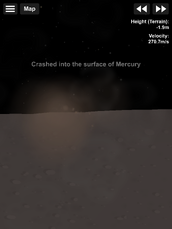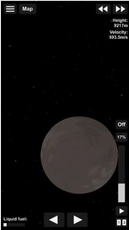Mercury is the closest and smallest planet to the Sun, preceded by Mars. It is a mottled gray airless, moonless world. Mercury is also one of the hardest planets to reach on due to the proximity to the sun and low gravity.
Mercury's surface is very rocky, and it has a lot of craters like the Moon. Mercury has 2 landmarks called Caloris Planitia and Borealis Planitia.
What to do on Mercury?[]
Due to the difficulty of orbiting and landing on around Mercury (and returning back to Earth), successful missions are seen as great achievement all over the SFS community.
The delta-v it takes can be reduced by multiple gravity assists off of Venus and Mercury itself, as well as sitting at low heliocentric orbit between Venus and Mercury, using Venus to go to Mercury, and many more.
If you feel you have gotten the hang of getting to Mercury, you can try building a Space Station or a refuelling station to aid future missions.
Atmosphere[]
Mercury has no atmosphere.
Terrain[]

Mercurian surface
Like the Moon or Callisto, Mercury has many craters. Unlike those two, however, Mercury’s craters are deeper and a little more spread apart.
Landing on Mercury can be difficult because of sometimes rough terrain and the lack of an atmosphere to use parachutes to slow down a rocket. A landing on Mercury would require plenty of fuel and retrorockets to slow down. The same is for orbiting Mercury without gravity assists.
If a player wants to get back to Earth, the amount of fuel would become much higher, due to the fact you need to use the planet Venus to get back to Earth easily.
Landmarks[]
There are only 2 landmarks on Mercury. Mercury has the lowest number of landmarks of any planet in the solar system.
Borealis Planitia (Latin for Northern Plain) is a plain on Mercury. It has several craters inside it. This can be a landing site for some landers because of its flatness.
Caloris Planitia (Latin for Plain of Heat) is a plain on Mercury; like Borealis Planitia, it has several craters and hills and it's marked by a mountain on the centre of it. At the sides of the basin there are a couple of tall mountains; they are called Caloris Montes (Mountains of Heat).
Achievements[]
There are two achievements that can be obtained on on Mercury:
- Captured into low Mercury orbit
- Landed on the surface of Mercury
Gallery[]
Information[]
- Mercury, like the moon, has a tiny little exosphere in real life. However, this probably wasn't added into the game because the atmosphere would be too thin to make a difference on the gameplay.
- Mercury's gravity is weaker than in real life. Its real life gravity is 3.7 m/s2
Trivia[]
- Mercury has a high density because it is mainly composed of iron.
- On the Spaceflight Simulator Forums, Mercury is often referred to as “The Graveyard” due to how difficult it is to orbit and land on.
- In 1.4, Stef Moroyna screwed up Mercury's texture while modifying it to make it more realistic, so it was white until it was fixed in 1.5.
- Mercury in real life has a thin atmosphere (or exosphere), composed of oxygen, hydrogen, helium, sodium and potassium.
- Mercury is also the closest planet of all planets in the solar system.
- In the game, Mercury shares the same size as Callisto, at 120 kilometers; in reality, Mercury is slightly larger than Callisto by 40 kilometers.
- In real life, 3 spacecraft explored Mercury: Mariner 10, MESSENGER and BepiColombo.
| Free | Planet DLC required | Upcoming/Custom | ||
| Sun • Mercury • Venus • Earth • Mars | Jupiter | Saturn • Uranus • Neptune | ||
| Mercury | ||||
| Venus | ||||
| Earth • Moon (Luna) • Captured Asteroid | ||||
| Mars • Deimos • Phobos | ||||
| ⠀ |
Jupiter • Io • Europa • Ganymede • Callisto | Metis • Thebe • Amalthea • Adrastea | ||
| Saturn • Mimas • Enceladus • Tethys • Dione • Rhea • Titan • Iapetus • Hyperion | ||||
| Uranus • Miranda • Ariel • Umbriel • Titania • Oberon | ||||
| Neptune • Triton • Proteus • Nereid • Larissa • Galatea | ||||
| Ceres • Pluto (Charon • Nix • Hydra • Stix • Kerberos) • Haumea (Hi'iaka • Namaka) • Makemake (MK2) • Eris (Dysnomia) • Sedna | ||||



